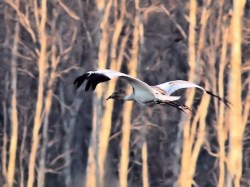
Kenneth Cole SchneiderWhooping cranes: just one of the species threatened by the Keystone XL pipeline.
Environmentalists lined up over the weekend to condemn a draft State Department report that found no compelling environmental reason not to build the Keystone XL pipeline.
The stretch of pipeline in question would bring tar-sands oil from Alberta, Canada, across the U.S. border and down through Montana, South Dakota, and Nebraska. The southern stretch of the pipeline, which will carry the oil to Gulf Coast refineries, is already more than halfway built.
The draft environmental impact statement concluded [PDF] that the proposed project would damage more than 100 acres of wetlands, increase temperatures in wildlife-rich streams, and threaten vulnerable species. If there are spills from the pipeline, they could dump oil into lakes, aquifers, and rivers.
The project would also lead to an increase in greenhouse gas emissions, but the department determined that if the pipeline is not built, that could trigger more global warming because the industry might then ship its oil via less efficient methods like rail and oil tanker. That claim drew widespread condemnation from activists and scientists.
From The Guardian:
Aside from the Sierra Club, other prominent scientists and environmental groups have criticised the State Department report. They say that the report ignores the idea that building the pipeline will encourage greater development of the tar sands and boost oil production of deposits that are seen as a highly pollutive resource which can cause widespread ecological damage as it is mined.
“The State Department is overlooking the fact that the pipeline is likely to trigger at least 450,000 barrels per day of additional tar sands production capacity,” said Stephen Kretzmann, executive director of Oil Change International, in a statement.
James Hansen, a Columbia University professor who is one of the world’s most respected experts on climate change, also issued a statement attacking the report’s findings. “To say that the tar sands have little climate impact is an absurdity,” he said.
Amid the outcry over climate change, less attention has been paid to wildlife that would be threatened by Keystone. Here are just some of the vulnerable species that could be harmed if the Obama Pipeline is built. The block quotes are taken directly from the State Department report [PDF], which also recommends measures to help conserve the species.
Whooping crane — listed as endangered by the federal government and also protected under the Migratory Bird Treaty Act
Whooping cranes could be impacted by collisions with power lines associated with the proposed Project. The majority of the proposed Project route crosses the central flyway whooping crane migration corridor in South Dakota and Nebraska, and the Rainwater Basin in south central Nebraska provides whooping crane migration habitat.
Greater sage-grouse — a candidate for protection under the Endangered Species Act
Approximately 190 miles of the proposed Project route would cross areas with greater sage-grouse habitat in Montana, of which 94 miles are classified as moderate to high-quality habitat for greater sage-grouse.
American burying beetle — listed as endangered by the federal government
Approximately 50 miles of the proposed Project Route in Nebraska would affect American burying beetle habitat; approximately 43 miles in South Dakota would affect suitable habitat for the species.
Western prairie fringed orchid — listed as a threatened species by the federal government
The proposed Project would pass near known populations of western prairie fringed orchid in Nebraska, and through land where the orchid may potentially occur in South Dakota. Clearing and grading of land associated with construction of the proposed Project (including pipeline and ancillary facilities) may potentially disturb western prairie fringed orchids, and may introduce or expand invasive species that already contribute to the orchid’s decline
Small white lady’s slipper — a perennial orchid listed as a threatened species by Nebraska
This species may potentially occur within suitable habitat along the proposed Project route in Nebraska.
You will soon be given 45 days to comment on the State Department’s draft report. Threatened plants and animals that could lose breeding grounds and die of electrocution if the project moves forward will receive no such opportunity.



